Tibet TransportationNon-Chinese passport holders (including those of Taiwan, Hong Kong SAR, Macau SAR and other countries) must have an Alien's Travel Permit as well as a valid passport and a visa to enter Tibet. A visa can be obtained from the local Chinese consulate in foreign countries. Since the government encourages group tours to Tibet the permit is issued only to tour groups traveling with a Chinese tour operator. Usually travel agencies can facilitate the application process. A permit for Tibet usually costs several hundred RMB (Chinese Yuan). Transportation condition in Tibet has changed greatly since the liberation in 1951 when packs of animals were the main mode of transportation in the region. Now highways and airlines are connecting it to other regions of China. Modern transportation ended the history of backward means of transportation in Tibet. Please read below for more information about arrival into and departure from Tibet, as well as different means of getting around the city.
Planes and Airport
Train
The Tibet Railway extends 1,956 kilometers from Xining, Qinghai Province to Lhasa, Tibet and is the world's longest railroad built atop a plateau. The Golmud-Lhasa section, constructed in 2001 extends 1,142 kilometers with the highest elevation being some 5,072 meters above sea level at Tanggula Range making it also the highest railway in the world. Great forethought, ingenuity and creativity overcame the engineering difficulties during construction, the design of the train itself, and the efforts made to protect the environment, flora and fauna. Scenes Along The Railway As the Tibet Railway traverse three mountain ranges and via many rivers and lakes, the sceneries along the Railway to the Roof of the World are marvelous and majestic. With 45 stations along the route offer visitors picturesque sceneries and impressive vistas among which nine are designated as sightseeing stations and have special sightseeing platforms. Famous sights including the Kunlun and Tanggula mountain ranges, Qinghai Lake, Kekexili and Tuotuo River, Grassland and so on, together with the rare wild animals will reward each tourist with lifelong unforgettable memories. 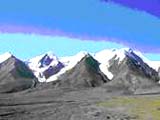
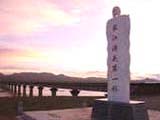
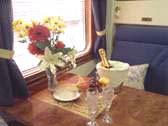
1. Mountain Yuzhun The first sightseeing station in the Golmud-Lhasa section of the Tibet Railway is Mount Yuzhu. With an altitude of 6,178 above the sea level, Mount Yuzhu is the main peak of Kunlun Mountain and a place favored by lovers of mountaineering. Standing on the sightseeing platform, one can admire the snow-covered Mount Yuzhu and glacier even in summer. Looking towards the southwest, Kekexili - the unmanned area - where over 100 rivers flow is worthy of appreciation. Other scenes such as jokul, gorge, stone forest, and saline can be seen from here. Reputed as the 'Kingdom of Animals', some rare wild animals such as Tibetan antelope, yak, etc. are often visible. 2. Chumaer River At Chumaer River station, visitors can see Chunaer River known as the central area of the Tibet antelope migration routes. Standing 2,565 meters (8,415 feet) long and 78 bridge holes, Chumaer River Bridge was built for wild animals to pass below. To the north, the majestic Qingshui River Bridge, the longest railroad bridge that also has animals' migration routes can be seen. Animals such as Tibetan antelope, wild donkey, and wild yak often appear near the bridges especially during the summer (June, July, and August). 3. Tuotuo River Springing from the main peak of Tanggula Range, Tuotuo River is where Yangtze River begins. Standing on the sightseeing platform here, the clear Tuotuo River, Highway Bridge 273 meters long over the river, and the first bridge of Yangtze River - Railroad Bridge of Tuotuo River - are easily seen and worth a visit. 4. Buqiangge Buqiangge railway station at an altitude of 4,823 meters (15,824 feet) is a place rich in plateau meadows, grasslands, and jokul. 5. Tanggula With an altitude of 5,068 meters (16,627 feet), Tanggula Station is the highest railway station above sea level in the world. Looking to the west from the station, one will become intoxicated with the charismatic scenery of Tanggula Mountain covered with snow all the year around. Also, the vast plains, lakes, Tanggula River and glacier are within one's sight. 6. Cuona Lake Covering an area of over 400 square kilometers, Cuona Lake is regarded as the highest freshwater lake in the world. Like Namtso Lake in Tibet, Cuona Lake means 'Heavenly Lake' to the Tibetans. Numerous believers often come all the way to worship this holy lake. The water here is crystal clear with fish jumping freely. Together with the boundless plains and clear sky, the scenery surrounding Cuona Lake are of great beauty, attracting cranes, mandarin ducks, swans and other wild animals. Around the lake is the famous Qiangtang Nature Reserve where Tibetan yak, donkey, snow leopard and so on live. Cuona Lake is the nearest lake to Tibet Railway with the nearest shore only tens of meters distant, so passengers can enjoy the serenity of the lake with great ease. 7. Nakchu The Nakchu railway station stands on the Qiangtang Plain which is one of the five biggest pastures in China. From the station, splendid vistas include the clear blue sky, lakes, plains, flocks of wild birds and the magnificent jokul are all within the passengers' vision. The Qiangtang Plain has a great reputation, and every year in August, the Nakchu Horse race is held here which attracts numerous people. 8. Damxung Damxung means 'the selected fine place' in Tibetan language. As it is 60 kilometers from Lhasa, and is called 'the north gate of Lhasa'. Medicinal plants and wild animals are numerous, including plants like lotus flowers, caladiums, and animals like Tibetan antelope, hares, argali, foxes, and lynx. People living in this mountainous region have come to regard the horse as an indispensable ally, assisting them in all aspects of their daily lives. Grand horse races are held in Damxung in August each year, lasting five to fifteen days. Nowadays, the race has expanded into a larger Native Games, including Tibetan style weight lifting, tug-of-war, and archery. It is a place where one can feel the friendliness and hospitality of the Tibetan people. It is also the fire-gathering place for the Asian Sports Meeting. Damxung railway station is regarded as the most characteristic Tibetan style architecture along the Tibetan railway. 9. Yangpachen Shuttling in the fast train to Tibet, one will be surprised to see some hot gases rise from the earth through natural outlets when arriving at Yangpachen, over 90 kilometers away from Lhasa. It is a place rich in earth heat resources and hot springs. The hottest namma in China and the largest earth heat power plant are situated here. As the hot spring contains sulphated hydrogen that has a beneficial effect on many chronic diseases, many tourists come here to enjoy the therapeutic and medicinal hot water. Because it is comparatively cold in the morning, heated gases issue from the earth, creating peculiar and spectacular scenes. With jokul and the glacier located to each side of Yangpachen, bathing in the hot spring is a special enjoyment, particularly in winter. City to City Bus There was no highway in Tibet before the liberation of Tibet. In the beginning of 1950, the People's Army of Liberation marched into Tibet. The soldiers joined in the construction of Sichuan-Tibet and Qinghai-Tibet highways (4360km in total length), which turned over a new leaf of transportation in Tibet. After the completion of tibet-Sichuan and Qinghai-Tibet highways, a trunk highway network has been established in Tibet including Yunnan-Tibet, Xinjiang -Tibet, Sino-Nepal highways. Over 100 highway transformation projects have been launched. 2000-kilometer-long pitch highway has been constructed. A highway network with Lhasa City at the core has taken shape. The total highway traffic mileage attains 24,808 km. There are five highways stretching into Tibet.
Travel Tips: Since Tibet is such a mountainous area at such a great altitude, it is prone to sudden and extreme changes in weather. Many safety aspects must be prepared for prior to travel departure to Tibet.
Train With 45 train stations in all, Lhasa and Tanggula stations are of the most charismatic, though all the stations blend the local architecture styles with the modern construction techniques. Lhasa Railway Station with its main colours of white and red is a typical traditional Tibetan style building and faces the famous Potala Palace. With an altitude of 5,068 meters (16,627 feet), and stands at the foot of Tanggular Mountain, Tanggula Station is the highest railway station in the world. It is also one of the nine major sightseeing stations from where visitors can appreciate the mignificent scene of the permanently snow covered Tanggula Mountain. 
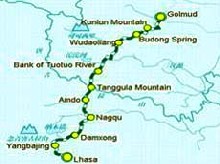
Public Minibuses In Lhasa minibuses are the main transportation, charging RMB 2 per person. Jeeps The conditions of minor roads are only passable by jeeps. Taxi It is easy to hire a taxi which is painted verdurous and silver. The fare is RMB 10 no matter where the destination is within the city. Pedicabs Pedicabs are unique vehicles to look around the highest city in the world. Bicycle Bikes can be easily hired at Lhasa at most hostels.

|

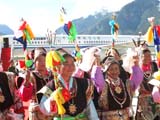 Planes are by far the fastest means to move to the Roof of the World. There are two airports in Tibet,
namely Gongga airport and Bangda airport. Lhasa Gongga Airport was open to traffic in 1956. While Gonggar
airport connects Lhasa with Chengdu, Xian, Beijing, Chongqing, and even Kathmandu and Hong Kong, traveling
by air into Tibet will surely brings visitors a unique and thrilling experience. Just imagine that you
are above the world highest snow and cloud clad peaks! However, since planes travel fast, there is
little time for acclimatization.
Planes are by far the fastest means to move to the Roof of the World. There are two airports in Tibet,
namely Gongga airport and Bangda airport. Lhasa Gongga Airport was open to traffic in 1956. While Gonggar
airport connects Lhasa with Chengdu, Xian, Beijing, Chongqing, and even Kathmandu and Hong Kong, traveling
by air into Tibet will surely brings visitors a unique and thrilling experience. Just imagine that you
are above the world highest snow and cloud clad peaks! However, since planes travel fast, there is
little time for acclimatization.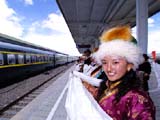 Since July 1st, 2006, the Tibet Railway has been open to traffic. Tibet Railway is a landmark achievement in Chinese
engineering and design, and in the process, creating world railway history. As the Railway to Tibet is of great
significance both to the Chinese and world railway history, and offers a new means for tourists to visit mysterious Tibet.
Since July 1st, 2006, the Tibet Railway has been open to traffic. Tibet Railway is a landmark achievement in Chinese
engineering and design, and in the process, creating world railway history. As the Railway to Tibet is of great
significance both to the Chinese and world railway history, and offers a new means for tourists to visit mysterious Tibet.